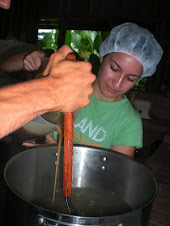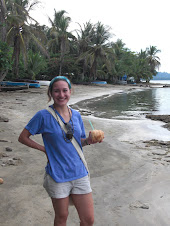Today I led a group in a yoga session for the first time! We have a group from the Rodale Institute, one of the oldest organic organizations in the States, staying with us and this morning some of them caught me coming back from doing yoga in the tower this morning and they mentioned how they wanted do some yoga themselves. After I got mats out for them one of them mentioned how excited they were to have me lead them in a yoga session. eek! I wasn’t planning on leading them! I’m more of an admirer of yoga and most of what I know is what I’ve picked up from guests who pass through. I was a bit timid at first, but I just gave my disclaimer and went ahead with it. Towards the end of the session I was getting more comfortable and walking around helping people to realign themselves and get a deeper stretch in various poses. Interesting experience for me; I really liked it. When I get back home I will look into learning more about yoga. I just love it. My flexibility has increased so much and it’s just such a great way to start the day!
Also this weekend we’re hosting a Cultivating Diversity think group where an interdisciplinary group of people came together to investigate avenues of change in agriculture systems. The great minds present included people from the NGOs, certifying agencies, universities, the ministry of agriculture, farmers, and students from EARTH, the top tropical agriculture university in the world. They were dreaming up ways of creating a future Costa Rica and how to implement changes that would increase self-sustainable and just agricultural systems. And despite the language barrier, I got to participate! Jann, the facilitator, was great. I learned so much about how to get a group of people to be creative and then organize their visions and ideas. Her method involved getting ideas down on lots of colored pieces of paper and then organizing this flurry of ideas onto corkboards. We finished the night with a dinner accompanied with Luna’s starfruit wine and ginger mead and a fermented biodynamic alcoholic drink that tasted like Kaluha. Yum!
In between the morning yoga session and the Cultivating Biodiversity meeting I made, with the help of Rocio, about 8 pounds of ginger candy. Rocio and I spent the entire late morning peeling ginger until our hands felt hot and tingly from the ginger juices. After I was done I though I would never want to eat ginger candy again, but by the evening I was just snacking away. They're quite addicting!
Saturday, November 15, 2008
Monday, November 10, 2008
Chocolate Making Attempt Thwarted by Mini Natural Disasters, and How to Keep Pesky Squirrels at Bay
Oh no! Just as I thought my cacao pods were coming along nicely—they almost smelled like chocolate a few days into the process—they began to mold! Everything molds during rainy season! My shoes, my backpack, my jewelry, and now my cacao! And after I remedied the mold issue they began to sprout! The embryo of the bean is supposed to shrivel and die in the fermentation process, not grow! But alas, I guess everything just grows in the rainforest. Also, the cacao beans began to be a breeding ground for little maggots. After assessing the myriad of problems, I had to toss all the beans into the forest area just outside the lodge (aka our non-food compost pile). I had two chocolate recipes to try too. One was a truffle recipe which used the whole bean, and the other was a real chocolate recipe. I have a new fermenting recipe to try for next time, and this one is full proof…I hope.
Also, I just learned how to control pests using a biodynamic method. It involves skinning the pest, such as a rat or squirrel, and charring the skin in a wood fire until it’s just ashes. Then, the ashes are spread around the plants and fields that need inoculation. Gustavo was using it to control rats in our food garden and now we’re going to use it against squirrels in our cacao fields, which are being ravished by squirrels and fungus. I was given instructions on how to char the skin just in case a dead squirrel is delivered to me this weekend when Gustavo isn’t going to be around. The only thing I didn’t get instructions on was how to skin a squirrel. It can’t be hard, right? I dissected rats in bio lab, so this shouldn’t be too far off.
Also, I just learned how to control pests using a biodynamic method. It involves skinning the pest, such as a rat or squirrel, and charring the skin in a wood fire until it’s just ashes. Then, the ashes are spread around the plants and fields that need inoculation. Gustavo was using it to control rats in our food garden and now we’re going to use it against squirrels in our cacao fields, which are being ravished by squirrels and fungus. I was given instructions on how to char the skin just in case a dead squirrel is delivered to me this weekend when Gustavo isn’t going to be around. The only thing I didn’t get instructions on was how to skin a squirrel. It can’t be hard, right? I dissected rats in bio lab, so this shouldn’t be too far off.
Monday, November 3, 2008
Tree Identification and Cacao
Identifying trees is tougher than identifying short shrubby plants! I went out today identifying trees with Roberto. To properly id a tree, it’s necessary to inspect the leaves, but since I cannot reach them by hand (canopy trees can be up to 20 meters tall) I had to use binoculars. I am not a fan of using binoculars and even using them for stationary objects, like leaves, is dizzying for me. I had to lie down on the ground and point the binoculars upwards, all the while being wary of being bitten by ants. And it's especially difficult to id trees in the rainforest since various trees are crowded together and leafy vines are growing on everything, making it confusing to figure out which leaf belongs to which plant. After spending half an hour identifying an Inga tree in the Fabaceae family (bean family), I narrowed it down to four possible species. Now I just need to wait until it's flowering or fruiting to be able to pin down the species.
I’m also fermenting cacao pods to make chocolate! We got 25 cacao pods from our cacao field. Using his machete, Fernando helped hack open the pods and I spread out the sweet mucilaginous beans onto a straw mat placed at the bottom of a drum container cut vertically in half. I then marched out in the garden, armed with a heavy kitchen knife, and retrieved a few banana leaves to cover the beans so they can ferment in the dark.
Also, funny side note speaking of chocolate. In the morning, after seeing Fernando make himself some chocolate milk using fresh milk, I really wanted a glass for myself. Later in the day I went down to the pool kitchen, where we keep our milk, and filled a little pitcher with a bit of milk. Once back at the main kitchen I set to work mixing in some sugar and cocoa powder. It was the richest chocolate milk I had ever tasted. In the morning I found out that the milk that I used to make my chocolate milk was not cow’s milk but buffalo milk! No wonder it was so creamy! Buffalo milk has a much higher fat content than cow’s milk, which makes it ideal for thick yogurts, cheeses, and butters.
I’m also fermenting cacao pods to make chocolate! We got 25 cacao pods from our cacao field. Using his machete, Fernando helped hack open the pods and I spread out the sweet mucilaginous beans onto a straw mat placed at the bottom of a drum container cut vertically in half. I then marched out in the garden, armed with a heavy kitchen knife, and retrieved a few banana leaves to cover the beans so they can ferment in the dark.
Also, funny side note speaking of chocolate. In the morning, after seeing Fernando make himself some chocolate milk using fresh milk, I really wanted a glass for myself. Later in the day I went down to the pool kitchen, where we keep our milk, and filled a little pitcher with a bit of milk. Once back at the main kitchen I set to work mixing in some sugar and cocoa powder. It was the richest chocolate milk I had ever tasted. In the morning I found out that the milk that I used to make my chocolate milk was not cow’s milk but buffalo milk! No wonder it was so creamy! Buffalo milk has a much higher fat content than cow’s milk, which makes it ideal for thick yogurts, cheeses, and butters.
Subscribe to:
Posts (Atom)






